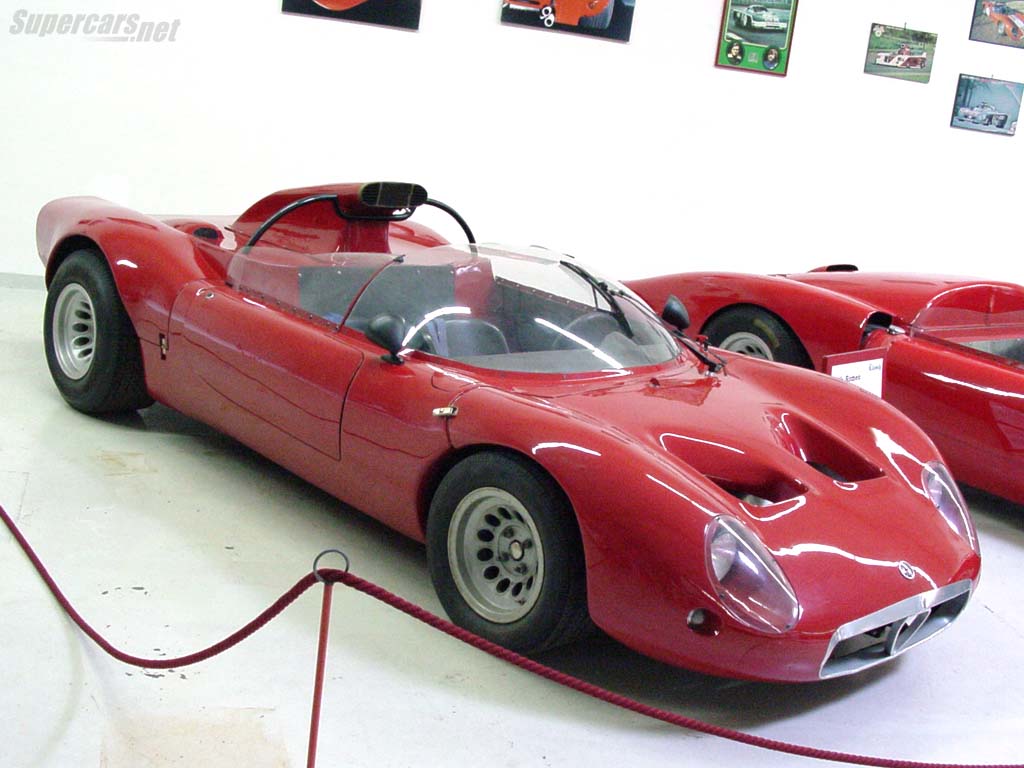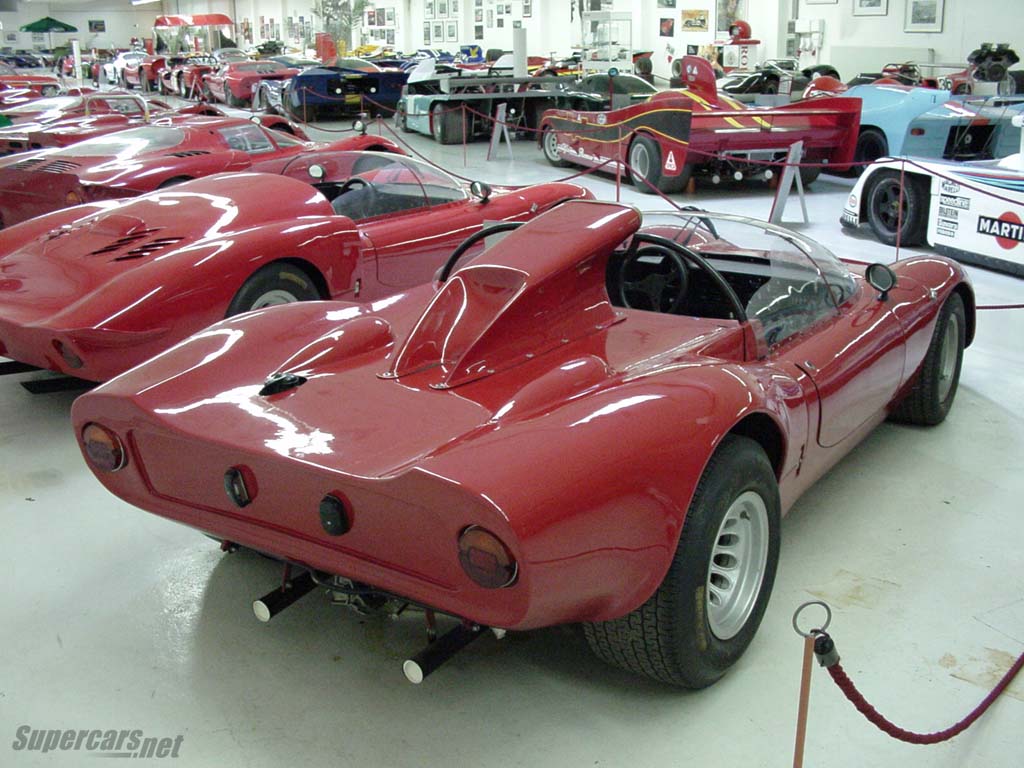1967 Alfa Romeo T33 ‘Perescopio’
After a successful campaign with the Tubulore Zagato (TZ) and the TZ2, Alfa’s racing wing known as Autodelta dedicated themselves to prototype racing. In 1967, the very first prototypes known as Tipo 33 (T33) were rolled out. During this formative year two different configurations were tested for the upcoming 1968 3-liter championship and the first was the Perescopio. These cars are easily identified by the shape of the air intake on the rear body section. This was necessary due to the lack of airflow over the rear body section to feed the engine and was a temporary design only used on the very first T33s.
33 Developments.
Leading up the 33’s debut at Fléron, Belgium, Autodelta became a public company owned primarily by Alfa Romeo. Under the direction of Carlo Chiti, Autodelta SpA was given the go ahead to race a 2-liter prototype in Group 6¹. They immediately turned their attention to a Scarabo Prototype which was first seen at the 1966 Paris Motor Show.
Designed by Guisseppe Busso under the direction of Oarzio Satta at Alfa Romeo, the Scarabo used a large-diameter H-frame chassis that also carried the fuel. These were riveted and made from exotic materials such as magnesium and aluminum alloy. Three Scarabos were completed by OSI. One turned into a concept car, but the others were tested at Autodelta for feasibility into a proper race car. These were known internally as project 105/33.
In 1966, Chiti became the director responsible for finalizing the 33’s design from the Scarabo prototypes¹. He had his team of engineers retain the Scarabo’s unusual H-frame chassis design, but constructed it entirely out of aluminum and then coated them inside with a plastic coating so they could double as 26 gallon fuel tanks. These were made at Areonautica Silcula, an aircraft company that had the necessary expertise.
The front and rear sections of the car were carried by a magnesium sub-frames with suspension pick-up points. These frames attached to the two ends of the H-Frame and were a critical point of failure in the initial design. Double wishbones were used all around, but the rear suspension made provisions for inboard brakes and a lower lateral arm.
In the middle of this chassis, Chiti had his team fit an entirely new 2-liter, aluminum V8 that drew inspiration from the Guilietta’s 4-cylinder.¹ Power was rated initially at 270 bhp using Lucas fuel injection but regular carburetion was tried later in the season. It’s rumored that Chiti was first designing his V8 engine while at Ferrari and walked out with the plans in 1962 when he left the company. It used a 180º flat-plane crankshaft, an aluminum alloy block and a dry sump lubrication system. Teddy Pilette of team VDS recalls “the engine in the early days was very fragile, so it was always going back to Milan for work.”¹
The initial body for the 33 was entirely new and two different styles were tried throughout the season. At the 1966 press launch at Alfa’s own Balocco test track, the car had a huge rear air intake and the press immediately nicknamed it the ‘Periscopica’. Chiti admitted this intake was borrowed from the Chaparral 2D. Alfa Romeo GP reported “In due course it will be decided how the lessons learned from this new venture can be used to improve the breed.”
33 Racing
1967 was a development year, but Autodelta was still keen to race and win the Targa Florio. They faced competition from Ferrari’s Dino and the Porsche 910. Not surprisingly, the 33 suffered from many retirements during the longer endurance races.
Owned by the Italian government, Alfa Romeo was keen to see the 33 win its debut race. Autodelta wisely chose a nearly unknown hill climb in Belgium called Fléron where the cars easily triumphed. It was later announced that Alfa would contest Sebring and the Targa.
At the prized Targa Florio, Autodelta prepared four cars and set sixth fastest time in qualifying. Nanni Galli and Teodoro Zeccoli led the 2-liter class for some of race but eventually their car gave out with front suspension failure. All the 33s would retire with similar grief.
The cars were prepared shortly thereafter for the Nürburgring 1000km, but only one car finished in fifth overall amidst a sea of Porsches. This was followed by several hill climb races until the 33’s next major race at Mugello.
Before the Mugello race in July 1967, it was found that the huge air intake on the Periscopica was causing considerable front end lift. For the closed public roads of Florence that made the Mugello circuit, Chiti had a new type of body style fitted which had a long tail and no prominent air intake. In this configuration the cars center of gravity moved forward and drag was decreased. 298 kph was also theoretically possible. Unfortunately, these upgrades did little to help the cars reliability and all three cars failed to finish. After the race, the long-tail version became known as Mugello.
From what seemed like an unsatisfactory season, Autodelta entered an obscure sports car race at Vallelunga with little opposition. The cars easily scored a 1-2 victory, but Chiti and everyone at Autodelta knew that new engineering was needed.
For the 1968 season, Autodelta prepared a stunning Stradale version and a new second-generation coupe which was almost entirely new.
Chassis & Sales
75033.004 – Resided in the Rosso Bianco collection for years. After being acquired by Louwman Collection along with the entire Rosso Bianco collection, this car was offered for sale by Simon Kidston. He described it as “a sympathetic restoration obviously some years ago though not with new mechanical components and electrical parts as with some of the other cars in the collection. This car has certain characteristics of the first 1967 cars including the original brass surround and mesh over the opening of the periscopic air intake. There is identifying information on the top of the front of the gearbox, a plate reading ‘9/41 Oil 6909’, and a number stamped on the gearbox ‘AD 27’. The bell-housing and gearbox also carry stamped numbers, ‘*0021’ which is the engine number, and presumably still has the matching gearbox. There is a small stamped number ‘17’ on the top of the cam-shaft cover. Suspension parts are original, used and tidied up, the engine compartment, cockpit and front suspension area have been painted, but clearly much of the spraying was just over existing original panels. The aluminum grill surround on this car appears to be original, with numerous small dents; some of these dents match the same piece on a photo of what we believe to be chassis ‘75033.004’ at the Nurburgring in 1967, but this is inconclusive”²
1. Collins, Peter et. al. Alfa Romeo Tipo 33.Veloce: December 2005.
2. Kidston, Simon. http://www.kidston.com. 2008
3.Chizzola, Gianni.Autodelta. Campanotto: 2004.
In Detail
| submitted by | Richard Owen |
| type | Series Production Car |
| released at | Balocco Press Conference |
| built at | Italian |
| engineers | Guisseppe Busso, Oarzio Satta, Carlo Chiti |
| production | 5 |
| engine | 90º V8 w/Dry Sump Lubrication |
| position | Mid, Longidutinal |
| aspiration | Natural |
| block material | Aluminum |
| valvetrain | Chain-Driven DOHC, 2 Valves per Cyl |
| fuel feed | Lucas Mark II Fuel Injection |
| displacement | 1995 cc / 121.74 in³ |
| bore | 78 mm / 3.07 in |
| stroke | 52.2 mm / 2.06 in |
| compression | 11.0:1 |
| power | 201.34 kw / 270 bhp @ 9600 rpm |
| specific output | 135.34 bhp per litre |
| bhp/weight | 465.52 bhp per tonne |
| body / frame | Aluminum Body over Aluminum Large-Diameter Frame w/Front & Rear Magnesium Subframes |
| driven wheels | RWD |
| front tires | 4.75×13 |
| rear tires | 6.00×13 |
| front brakes | Vented Discs |
| rear brakes | Inboard Vented Discs |
| front wheels | F 33.02 x 20.32 cm / 13 x 8 in |
| rear wheels | R 33.02 x 22.86 cm / 13 x 9 in |
| steering | Rack & Pinion |
| f suspension | Double Wishbones w/Coil Springs, Telescopic Shock Absorbers, Anti-Roll Bar |
| r suspension | Double Wishbones w/Radius Rods, Coil Springs, Telescopic Shock Absorbers, Anti-Roll Bar |
| curb weight | 580 kg / 1278.90 lbs |
| wheelbase | 2250 mm / 88.58 in |
| front track | 1340 mm / 52.76 in |
| rear track | 1450 mm / 57.09 in |
| length | 3960 mm / 155.91 in |
| width | 1760 mm / 69.29 in |
| height | 990 mm / 38.98 in |
| transmission | Colotti 6-Speed Manual |
| top speed | ~273.53 kph / 170 mph |















